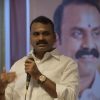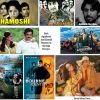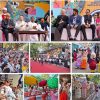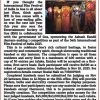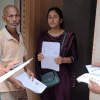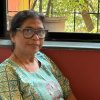Goa is abuzz with excitement as vintage bike and car owners, users, collectors and fans are decking […]
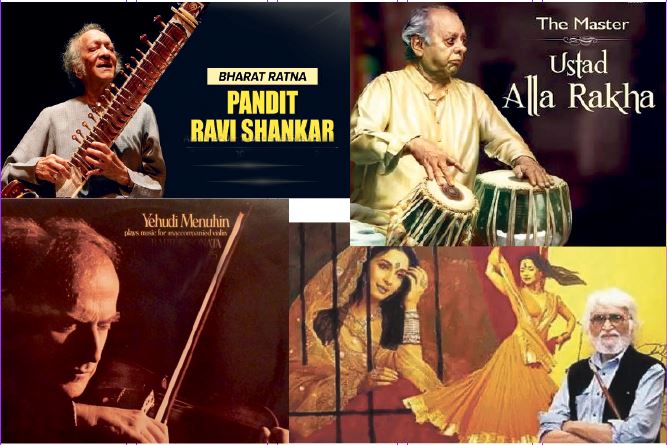
(17th Instalment)BOMBAY, MY FINISHING SCHOOL!
Life & Living, MEMOIRS, Nov 30- Dec 06 2024 November 29, 2024Rajan Narayan
MEMOIRS OF AN UNDERDOG JOURNALIST!
“I have no sacred cows!’ `I’m the goonda with the pen!”
WHEN I moved from Bangalore to Mumbai, I was still a country bumpkin. I did not know of or have social graces we take for granted amongst the educated classes. I had no knowledge of either the fine arts or the performing arts either. The fine arts are painting, sculpture, etc. The performing arts embrace a wide variety of music and dance schools.
Man does not live by bread alone. Just as we indulge the body by trying out various food preparations, we also need to develop the mind and the sensory organs. For this, you have to be open to new experiences. The reason why Bombay is seen as a finishing school for many is because it offers more diverse opportunities to grow than any other city in the country.
Being educated does not mean only being able to acquire degrees. It demands that you experience the entire range of cultural experiences available. Being cultured does not mean having only social graces. It means knowing when and where to say thank-you and please, when to do a Namaste or shake hands, how to air kiss – a popular form of kissing amongst celebrities who comprise high society the world over.
Or for that matter there are rules on how to respect women and senior citizens. Among the various people I have met it is the Portuguese-bred Goans who I have found to be amongst the most cultured in the world. My old-time Portuguese friends will still believe in opening the door for women of all ages and expressing their devotion to senior citizens. They are the epitome of politeness. Being cultured particularly in Western ways means more than good table manners. You must know how to use knife and fork and spoon for various dishes and know how to choose a good wine. In fine dining, the sommelier, a name for the waiter who serves wine, will first bring you the bottle of wine you ordered. He will pour a small quantity into the wine glass. You are expected to taste it and give your approval for service.
There are red wines, white wines and sparkling wines called Champagne. If you want to be considered an expert on whisky you have to know the difference between single-malt and the normal premium whisky like Johnny Walker. You need to know the different kinds of gin. More importantly, you need to know what wine goes with what food. Also while whisky may be taken with water, gin is served in tonic water with lemon juice. Then there is the aperitif. Which are taken after dinner, namely the liqueurs. This includes cognac, a form of excellent brandy. It also includes Drambuie, a coffee liquor, or Cointreau or Baileys Irish coffee.
In a fine dining dinner is normally served in several courses. The first course may be of starters or light snacks. The second course is normally soups, the third course is the main dish and the last course is dessert. It’s all topped up by coffee with a little brandy in it and of course the men will retire to another room for their cigar fix over small business talk may be.
The first time I learnt about a four course meal or more elaborate dinners was at various embassy dinners in Mumbai. Subsequently, I came to Goa and remember on Raj Bhavan visits in the 80s and 90s there used to be sit-down four-course dinners whenever a VIP came visiting Goa. There was a different set of crockery and cutlery and indeed, even different wines poured with every course.
But being cultured means much more than social graces. It means an endless curiosity. A willingness to learn and expose oneself to a variety of influences. Unfortunately, people put themselves in compartments. They limit their experience in music to Hindustani, Carnatic or Western music. For the best joyful experience, you have to understand the unique quality of every form of music from classical to country folk to modern pop and now Sunburn EDM trance fusion music.
My introduction to Hindustani classic music came in the form of concerts which were held at the Rang Bhavan open-air auditorium near Xavier’s college in Mumbai. All the legendary Hindustani classical musicians used to perform and their concerts or baithak used to begin at 10 pm and end at 6 am. These were my first introduction to the greats of vocal music like Kumar Gandharva and Bhimsen Joshi. Then there were the instrumentalists Alla Rakha on the tabla and Hariprasad Chaurasia with flute “Bansuri.” And there was of course Pandit Ravi Shankar on the sitar and Shiv Kumar Sharma on the sarangi, a unique instrument. The counterpart of Hindustani classical music is Carnatic classical music.
I had early exposure to music in Bengaluru where MS Subbulakshmi, who was the equivalent of Lata Mangeshkar, used to give her music performances. The most exciting experience was to attend the concerts of the Madras Music Academy which provided the platform for the best in Carnatic music. Mumbai is a melting pot of all cultures and music represented these all at the Shree Shanmukhananda Chandrasekarendra Saraswathi Auditorium where they even had special Carnatic music festivals.
I got introduced to Western classical music too during my years in what was then Bombay. The major difference between Indian and Western classical music is that in the latter all compositions are written. Unlike in the Indian tradition where it is vocal training mostly. My first introduction to Western classical music was a concert by Yehudi Menuhin, international music composer of Bombay origins, way back in 1981. He performed at the magnificent Tata Auditorium at Nariman Point. This was my first introduction to classical Western composers like Mozart and Beethoven.
In Goa recently the Stuti choir performed the works of the very reputed Italian composer Gioachino Antonio Rossini. Western music performances are grand occasions engaging an orchestra of maybe over a hundred musicians. I’ve also had the rare privilege of attending concerts while visiting London in England.
Come to dancing, the world of dance is again very diverse. There are the familiar classical Indian dance schools of Bharatnatyam, Kathakali, Kuchipudi, Mohiniyattam, Odissi. Then is the classical Western ballet which is an exquisite dance form where the entire dancer’s body expresses a range of emotions from love to hate to fear, etcetera. I recall experiencing a Russian Swan Lake ballet performance and it still lingers in mind for its great charm.
In Goa there are of course folk dances ranging from the traditional mando, dhalo, dekhni; the Gujarati garbo and dandiya-ras too has become popular due to the celebration of the nine days of Navratri. There is also the highly stylized Spanish dance called the Flamenco and Goa’s own Fado which is of Portuguese origin. You need to experience all kinds of dance and music forms and then decide what you like and what gives you the greatest pleasure.
To fully enjoy life you also have to see and experience great art. My first wife Bhanu was a painter and an art historian. But even before we had got married I used to visit the art galleries in Mumbai regularly. I also read books on the arts extensively. To catch up with great artists like Picasso and Vincent Van Gogh whose paintings including the one of sunflowers which my partner and wife Tara is so fond of. Not to forget Paul Gauguin who painted the luscious Pacific islands landscape scenes.
Most Indian artists have been strongly influenced by great European artists. Over the years I became familiar with the work of senior Indian artists like MF Hussain who won fame and fortune for painting horses. He got into a controversy painting Hindu goddesses without too much clothing on and got into trouble and had to even flee to the Gulf countries to live in peace. Then there was Akbar Padamse, a master of colors. Our Goan artists are Vasudeo Gaitonde and Francis Newton Souza whom most every art lover is familiar with. Among the second generation of artists, I became very fond of Sudhir Patwardhan and Nalini Malini. I spent several months at the Baroda School of Arts where I learnt more about art, perhaps the best introduction to art is the small book titled “Ways of Seeing” by John Berger, he offers a classical history of the arts.
I am writing these memoirs of my introduction to art and culture. And how they added to my experience of life. Every form of artistic expression expands your mind and heart. This is why every young Goan should participate in the Serendipity festival coming up from December 15 to 22, 2024. The multimedia, multi-cultural covers experiences from food to dance to music to arts and crafts. Various workshops and performances explore the fusion between various art forms whether it is culinary adventures or new forms of ballet to teach you about various parts of body beautiful and how to integrate them harmoniously. Serendipity, is being curated by theatre personality Quasar Thakore Padamsee amongst others and it allows you to experience the best in music, dance, arts and crafts and not least of all food. A unique exhibition is put up every year at the Adil Shah Palace. This year there is a special focus on creative experiences for children. Register yourself online and let all your senses feast on the joys of discovering light, darkness, sounds, scents and much more for a total experience and awakening to what life has to offer in a lifetime.


